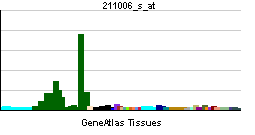KCNB1
| Potassium voltage-gated channel, Shab-related subfamily, member 1 | |||||||||||
|---|---|---|---|---|---|---|---|---|---|---|---|
| Identifiers | |||||||||||
| Symbols | KCNB1 ; DRK1; KV2.1; h-DRK1 | ||||||||||
| External IDs | Template:OMIM5 Template:MGI HomoloGene: 37988 | ||||||||||
| |||||||||||
| RNA expression pattern | |||||||||||
 | |||||||||||
| More reference expression data | |||||||||||
| Orthologs | |||||||||||
| Template:GNF Ortholog box | |||||||||||
| Species | Human | Mouse | |||||||||
| Entrez | n/a | n/a | |||||||||
| Ensembl | n/a | n/a | |||||||||
| UniProt | n/a | n/a | |||||||||
| RefSeq (mRNA) | n/a | n/a | |||||||||
| RefSeq (protein) | n/a | n/a | |||||||||
| Location (UCSC) | n/a | n/a | |||||||||
| PubMed search | n/a | n/a | |||||||||
Potassium voltage-gated channel, Shab-related subfamily, member 1, also known as KCNB1 or Kv2.1, is a human gene.[1]
Voltage-gated potassium (Kv) channels represent the most complex class of voltage-gated ion channels from both functional and structural standpoints. Their diverse functions include regulating neurotransmitter release, heart rate, insulin secretion, neuronal excitability, epithelial electrolyte transport, smooth muscle contraction, and cell volume. Four sequence-related potassium channel genes - shaker, shaw, shab, and shal - have been identified in Drosophila, and each has been shown to have human homolog(s). This gene encodes a member of the potassium channel, voltage-gated, shab-related subfamily. This member is a delayed rectifier potassium channel and its activity is modulated by some other family members.[1]
See also
References
Further reading
- Gutman GA, Chandy KG, Grissmer S; et al. (2006). "International Union of Pharmacology. LIII. Nomenclature and molecular relationships of voltage-gated potassium channels". Pharmacol. Rev. 57 (4): 473–508. doi:10.1124/pr.57.4.10. PMID 16382104.
- Melis R, Stauffer D, Zhao X; et al. (1995). "Physical and genetic localization of a Shab subfamily potassium channel (KCNB1) gene to chromosomal region 20q13.2". Genomics. 25 (1): 285–7. PMID 7774931.
- Albrecht B, Lorra C, Stocker M, Pongs O (1994). "Cloning and characterization of a human delayed rectifier potassium channel gene". Recept. Channels. 1 (2): 99–110. PMID 8081723.
- Hugnot JP, Salinas M, Lesage F; et al. (1996). "Kv8.1, a new neuronal potassium channel subunit with specific inhibitory properties towards Shab and Shaw channels". EMBO J. 15 (13): 3322–31. PMID 8670833.
- Post MA, Kirsch GE, Brown AM (1997). "Kv2.1 and electrically silent Kv6.1 potassium channel subunits combine and express a novel current". FEBS Lett. 399 (1–2): 177–82. PMID 8980147.
- Patel AJ, Lazdunski M, Honoré E (1998). "Kv2.1/Kv9.3, a novel ATP-dependent delayed-rectifier K+ channel in oxygen-sensitive pulmonary artery myocytes". EMBO J. 16 (22): 6615–25. doi:10.1093/emboj/16.22.6615. PMID 9362476.
- Shepard AR, Rae JL (1999). "Electrically silent potassium channel subunits from human lens epithelium". Am. J. Physiol. 277 (3 Pt 1): C412–24. PMID 10484328.
- Zhu XR, Netzer R, Böhlke K; et al. (1999). "Structural and functional characterization of Kv6.2 a new gamma-subunit of voltage-gated potassium channel". Recept. Channels. 6 (5): 337–50. PMID 10551266.
- Peretz A, Gil-Henn H, Sobko A; et al. (2000). "Hypomyelination and increased activity of voltage-gated K(+) channels in mice lacking protein tyrosine phosphatase epsilon". EMBO J. 19 (15): 4036–45. doi:10.1093/emboj/19.15.4036. PMID 10921884.
- Deloukas P, Matthews LH, Ashurst J; et al. (2002). "The DNA sequence and comparative analysis of human chromosome 20". Nature. 414 (6866): 865–71. doi:10.1038/414865a. PMID 11780052.
- Sano Y, Mochizuki S, Miyake A; et al. (2002). "Molecular cloning and characterization of Kv6.3, a novel modulatory subunit for voltage-gated K(+) channel Kv2.1". FEBS Lett. 512 (1–3): 230–4. PMID 11852086.
- Kurata HT, Soon GS, Eldstrom JR; et al. (2002). "Amino-terminal determinants of U-type inactivation of voltage-gated K+ channels". J. Biol. Chem. 277 (32): 29045–53. doi:10.1074/jbc.M111470200. PMID 12021261.
- Ottschytsch N, Raes A, Van Hoorick D, Snyders DJ (2002). "Obligatory heterotetramerization of three previously uncharacterized Kv channel alpha-subunits identified in the human genome". Proc. Natl. Acad. Sci. U.S.A. 99 (12): 7986–91. doi:10.1073/pnas.122617999. PMID 12060745.
- MacDonald PE, Wang G, Tsuk S; et al. (2003). "Synaptosome-associated protein of 25 kilodaltons modulates Kv2.1 voltage-dependent K(+) channels in neuroendocrine islet beta-cells through an interaction with the channel N terminus". Mol. Endocrinol. 16 (11): 2452–61. PMID 12403834.
- Strausberg RL, Feingold EA, Grouse LH; et al. (2003). "Generation and initial analysis of more than 15,000 full-length human and mouse cDNA sequences". Proc. Natl. Acad. Sci. U.S.A. 99 (26): 16899–903. doi:10.1073/pnas.242603899. PMID 12477932.
- Ju M, Stevens L, Leadbitter E, Wray D (2003). "The Roles of N- and C-terminal determinants in the activation of the Kv2.1 potassium channel". J. Biol. Chem. 278 (15): 12769–78. doi:10.1074/jbc.M212973200. PMID 12560340.
- Tiran Z, Peretz A, Attali B, Elson A (2003). "Phosphorylation-dependent regulation of Kv2.1 Channel activity at tyrosine 124 by Src and by protein-tyrosine phosphatase epsilon". J. Biol. Chem. 278 (19): 17509–14. doi:10.1074/jbc.M212766200. PMID 12615930.
- Consiglio JF, Korn SJ (2004). "Influence of permeant ions on voltage sensor function in the Kv2.1 potassium channel". J. Gen. Physiol. 123 (4): 387–400. doi:10.1085/jgp.200308976. PMID 15024041.
- Thébaud B, Michelakis ED, Wu XC; et al. (2005). "Oxygen-sensitive Kv channel gene transfer confers oxygen responsiveness to preterm rabbit and remodeled human ductus arteriosus: implications for infants with patent ductus arteriosus". Circulation. 110 (11): 1372–9. doi:10.1161/01.CIR.0000141292.28616.65. PMID 15353504.
- Kerschensteiner D, Soto F, Stocker M (2005). "Fluorescence measurements reveal stoichiometry of K+ channels formed by modulatory and delayed rectifier alpha-subunits". Proc. Natl. Acad. Sci. U.S.A. 102 (17): 6160–5. doi:10.1073/pnas.0500468102. PMID 15827117.
External links
- Kv2.1+Potassium+Channel at the US National Library of Medicine Medical Subject Headings (MeSH)
- KCNB1+protein,+human at the US National Library of Medicine Medical Subject Headings (MeSH)
| Stub icon | This membrane protein–related article is a stub. You can help Wikipedia by expanding it. |
This article incorporates text from the United States National Library of Medicine, which is in the public domain.